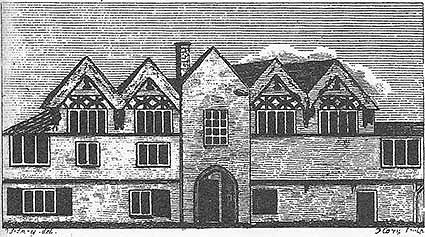
Steyning Museum: Motley Schoolmasters
You would have expected that John Morgan and John Evans would have been respected pillars of Steyning Society in the late 18th and early nineteenth century; they were both reverend gentlemen and were, in succession, heads of Steyning Grammar School. But you would have been wrong.Morgan came to the Grammar School in 1778 and finally retired in 1817. He was required by the ordinances established in 1614 to teach Latin and Greek (and little else) but, either as a result of his own idleness or the disinterest of local people in 'the learned languages' the number of pupils fell disastrously. When his nephew, John Evans, joined him in 1815 he reported that there were only two free scholars and no boarders, and added 'but those who were there came to school irregularly and I cannot state the number precisely'.
Morgan’s salary was derived by renting out the School’s holdings of land which, at the start, generated a paltry £20 but, with inflation, eventually provided a very respectable income. However he seems to have disregarded the fact that the rental income should also have been used for the upkeep of the School building. The dilapidated condition of the School coupled with the rather obvious shortage of pupils did not please either the School’s trustees or the local community and in 1804 Morgan was described as a 'contumacious master' whose 'duty is not performed'.
John Evans was not much better. He was given a bit more latitude in what he could teach which helped pupil numbers a little but he steadfastly refused to let workmen into the School to effect any repairs. When he eventually left in 1840 he even took the key with him and the trustees had to apply to the Bishop of Chichester for permission to force an entry and start the repair work.
To be fair to the Reverend John Morgan he recognised the shortcomings of the curriculum (and of his income) and in 1802 attempted to set up a parallel ‘academy’, in partnership with James Dunn, for 'young gentlemen to be educated in Greek, Latin, the English Classics, Ancient and Modern Geography, the French Tongue, Writing, Arithmetic and Book Keeping at 25 guineas per annum... Measuration, Navigation, Fortification, Music, Drawing, Dancing etc. are extra'. They claimed that 'the seeds of piety and liberality will be carefully conveyed into their young minds by example as well as precept'.
But nothing came of it. The partnership was dissolved after six weeks. Why we don’t know.
Questionable standards of teaching and problems of school buildings being in a poor state of repair were not too uncommon at this time. In Mayfield in East Sussex when Mr. Gale entered his school for the first time he found the schoolhouse 'in a flow, by reason of the snow and rain coming through the leads.' He then greeted his new pupils with some words of exhortation, set them to copy and recopy an 'extempore verse' and forthwith adjourned to the Star Inn for the rest of the morning.
Perhaps today's school teachers would have some fellow feeling for schoolmasters of the past, such as the Reverend John Morgan who had to teach to such a severely circumscribed curriculum. But it has not always been like that. The late Joyce Sleight recalled how in the 1960’s and ‘70’s Ron Tulley instructed his pupils in practical economics (with considerable success it should be said). At the time there was a betting shop just outside the back gate into the Grammar School so he taught gambling. The class all had their ‘systems’ and kept their own numbers, regularly betting on the greyhounds in lessons.
One must doubt whether this would have chimed either with the original ordnances of the Grammar School, or with John Morgan’s ambition to instill 'piety and liberality into young minds', let alone with the acknowledged issues associated with gambling.
Image: Steyning Grammar School in 1804 when the Reverend John Morgan was head master

